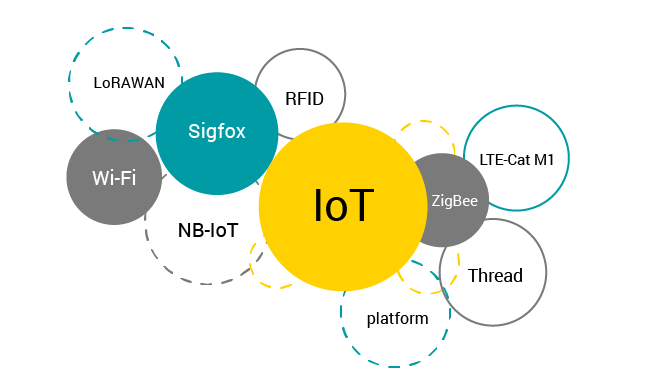The Internet of Things (IoT) connects everyday objects like home appliances, vehicles, sensors, and industrial machinery to the internet, enabling them to collect and share data. IoT systems create smart environments for homes, industries, cities, and healthcare.

Key Components of IoT Technology

1. Device Hardware in IoT
2. Device Software
How IoT Makes Devices Smart
Devices are made "smart" by enabling the following functionalities:
Real-time analysis: Devices process and analyze data quickly (e.g., a smoke detector that triggers an alarm when smoke is detected).
User interaction: Apps or interfaces allow users to control IoT devices (e.g., smartphone apps to control home lights).
3. Communication Layer
Devices need to send and receive data. This layer ensures connectivity using:
Physical networks:
Wi-Fi, Bluetooth, cellular networks (e.g., 4G, 5G), or satellite connections.
Communication protocols:
ZigBee: Low-power protocol for smart homes.
MQTT: Lightweight protocol for IoT devices to send messages.
Thread: Used in home automation for secure device-to-device communication.
4. IoT Platforms
Platforms collect, manage, and analyze IoT data. They present useful insights to users via dashboards or apps.
Functions of an IoT platform:Data collection: Gather information from devices.
Device management: Monitor and control devices remotely.
Data analysis: Find patterns or trends in the data.
Examples: Cloud-based platforms like AWS IoT or Microsoft Azure IoT.
1. Short-Range Solutions
- For devices close to each other (within a few meters).
- Examples:
- Bluetooth:
- Used in wearables and wireless headphones.
- Bluetooth Low Energy (BLE) consumes less power but handles smaller data volumes.
- RFID (Radio-Frequency Identification):
- Used in logistics, supply chains, and retail stores to track items.
- Bluetooth:
2. Medium-Range Solutions
- For devices within a building or nearby locations.
- Examples:
- Wi-Fi:
- Commonly used in homes and offices.
- Offers fast data transfer but consumes more power.
- ZigBee:
- A low-power protocol used in home automation (e.g., smart lights).
- Wi-Fi:
3. Long-Range Solutions
- For devices spread across large areas, like cities or industrial zones.
- Examples:
- LoRaWAN (Long Range Wide Area Network):
- Used in smart cities and agriculture for monitoring devices across long distances.
- Sigfox:
- Low-cost, low-power communication for environmental monitoring.
- NB-IoT (Narrowband IoT):
- Connects devices like smart meters with minimal power consumption.
- LoRaWAN (Long Range Wide Area Network):

Some Additional Technologies Behind IoT
1. Edge Computing
Processes data close to the device instead of sending it to the cloud. Reduces delay and saves bandwidth. Example: Security cameras analyzing footage locally.
2. AI and Machine Learning (ML)
AI makes devices intelligent; ML helps them learn from data. Example: Predicting machine failure in factories.
3. Cloud Computing
Stores and processes IoT data online. Example: Smart cities managing traffic with cloud-based systems.
4. Big Data Analytics
Analyzes large IoT data for insights. Example: Detecting health patterns from wearable devices.
5. Blockchain
Secures IoT data and ensures trust with tamper-proof records. Example: Tracking products in supply chains.
6. Digital Twins
Virtual replicas of physical objects for simulation and monitoring. Example: Testing smart car systems virtually.
7. 5G Technology
Provides faster, reliable connections for massive IoT devices. Example: Real-time control of autonomous cars.
8. RFID (Radio Frequency Identification)
Tracks objects using wireless signals. Example: Managing inventory in warehouses.
9. NFC (Near Field Communication)
Enables short-range communication between devices. Example: Contactless payments.
10. Energy Harvesting
Powers IoT devices using environmental energy like solar or vibrations. Example: Solar-powered sensors for smart farms.
These technologies work together to make IoT smarter, faster, and more efficient!